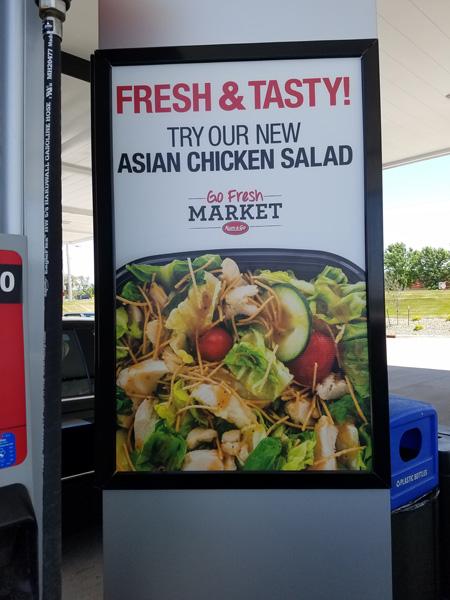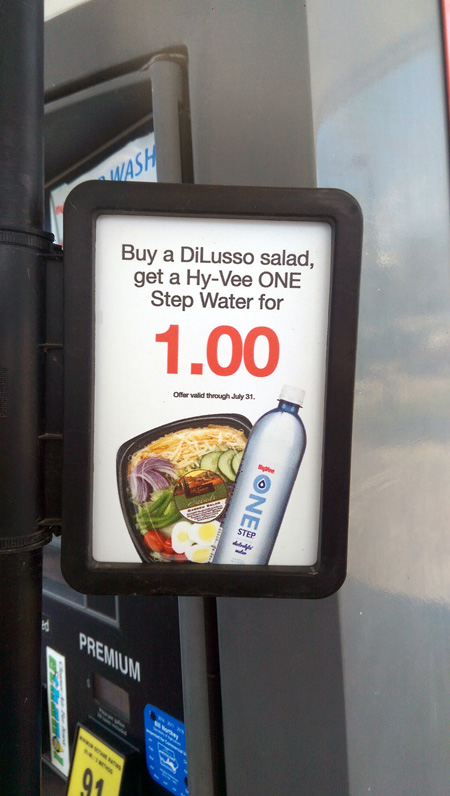By Frank Beard, NACS Daily Contributor
Although I’m impressed by the large number of convenience stores that provide access to fresh, healthful products, there’s still a disconnect in communicating this to customers. Many stores offer little to no indication that they carry healthful products—unless customers physically walk inside.
Last summer, when I was near the Oklahoma City airport, I reluctantly stopped at a location from a major brand that had questionable curb appeal and an enormous promo about a deal on 32-ounce fountain drinks. But when I ventured inside, I also discovered salads, fruit, vegetables, mixed nuts, low-sugar snack bars and other similar products.
This made me wonder how many customers might have come inside if they knew these products were available? How many would have purchased food in addition to fuel?
Part of the issue in not promoting healthful options is that such marketing comes at the expense of tried-and-true traditional products. But that’s incorrect. It’s not about promoting one over the other, but rather telling customers that you have something for everyone.
The good news? This doesn’t have to be complicated. And it can begin with a few simple steps.
Step 1: Reach customers at the pump. You may already have promotions displayed at or near the pump, but do any of them show your healthful offerings?
At my local HyVee Gas, each pump’s hose has a small plastic frame attached to hold inserts for various promotions. Some of these show traditional products, but many show healthful products as well. It’s a great strategy, because even if a customer doesn’t want the salad and bottled water I saw on one promotion, they know other healthful products are likely sold inside.
Kum & Go does something similar. As I write this column, I’m using the outdoor seating at one of their new marketplace stores. Across the parking lot, a customer is pumping gas into his SUV and staring at a poster for one of their new salads.
Step 2: Reach customers on social media. Many convenience stores maintain active social media accounts. Sheetz, for example, looks for positive comments about its stores on Twitter, retweets and shares with their followers, and generally replies with witty humor.
But I’m stunned by the number of stores that make no mention on social media of their healthful products. Instead, I often see promotions for soda, chips, donuts, sugary coffee drinks and indulgent hot food. Again, there’s nothing wrong with promoting those products. The point, rather, is that these stores could broaden their appeal and reach even more customers if they also promoted their healthful offerings.
Mix it up a bit. Share occasional photos of fresh-cut fruit and vegetables, new snack bars, lower-calorie options and other better-for-you products. Show your social media followers that you offer something for everyone.
Step 3: Manage your presence on online apps. Whether it’s Google, GasBuddy, or Yelp, I’m consistently amazed by the number of stores that ignore these free tools.
There’s an independent store near my hometown of Des Moines that has a fantastic selection of healthy snacks in addition to one of the best made-to-order menus of indulgent sandwiches that I’ve encountered. I’m from Iowa, so let’s just say I know a good tenderloin when I see one.
But if I was a new student at the local university and found the store on Google Maps, I wouldn’t know any of this. There’s limited reviews, no photos, and no indication that it’s a quality store.
Google allows business owners to claim each store and manage its profile. Take photos of your best products and of the store itself—make it look like an active, happening place. If there’s negative reviews that can be resolved, Google allows you to respond to them directly. All of this can be done in a matter of minutes and costs nothing.
Your presence on mobile apps is an increasingly important quality signal. Don’t ignore it.
Frank Beard is a regular NACS Daily contributor who has traveled to more than 1,000 convenience stores in 24 states. He raised awareness of the industry's healthful food options with his "30 Days of Gas Station Food" experiment, and he's an analyst/evangelist for convenience store and retail trends at GasBuddy.

